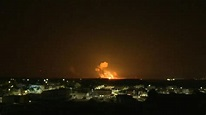Featured
article
- Get link
- X
- Other Apps
Wall Street Futures Slip Amid Escalating Middle East Tensions
.png)
U.S. stock index futures edged lower on Tuesday as the ongoing conflict between Israel and Iran continued to weigh on investor sentiment. The airstrikes and military escalations, now in their fifth day, have raised concerns about disruptions to oil exports from the Middle East, pushing crude prices higher.
Energy stocks saw gains in premarket trading, with Chevron and Exxon rising nearly 1% each, as oil prices remained elevated due to uncertainty in the region. Meanwhile, broader market indices struggled, with Dow E-minis down 269 points (0.63%), S&P 500 E-minis falling 37.25 points (0.62%), and Nasdaq 100 E-minis dropping 138.5 points (0.63%).
Investors are also closely watching the Federal Reserve’s upcoming policy meeting, scheduled for Wednesday. The central bank is widely expected to keep interest rates unchanged, but traders are pricing in potential rate cuts later in the year.
As geopolitical tensions persist, market participants are shifting toward safe-haven assets, with U.S. Treasury yields dipping across the curve. The uncertainty surrounding the Middle East conflict and its potential economic impact continues to drive volatility in global financial markets.
Popular Posts
Trump's Six Words: "I'm Going to Stop the Wars"
- Get link
- X
- Other Apps
Midnight Blast Shakes Gaza Skyline Amid Rising Tensions
- Get link
- X
- Other Apps



Comments
Post a Comment